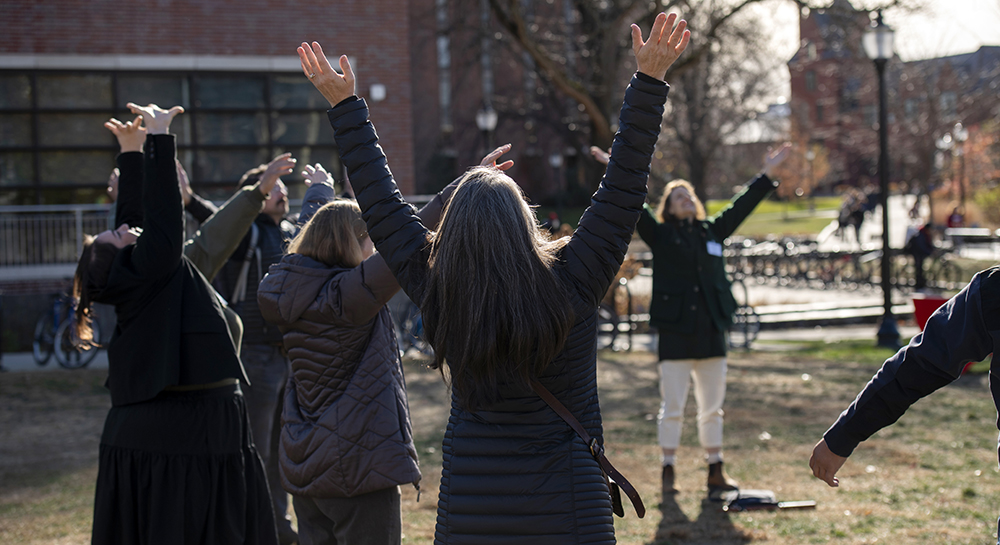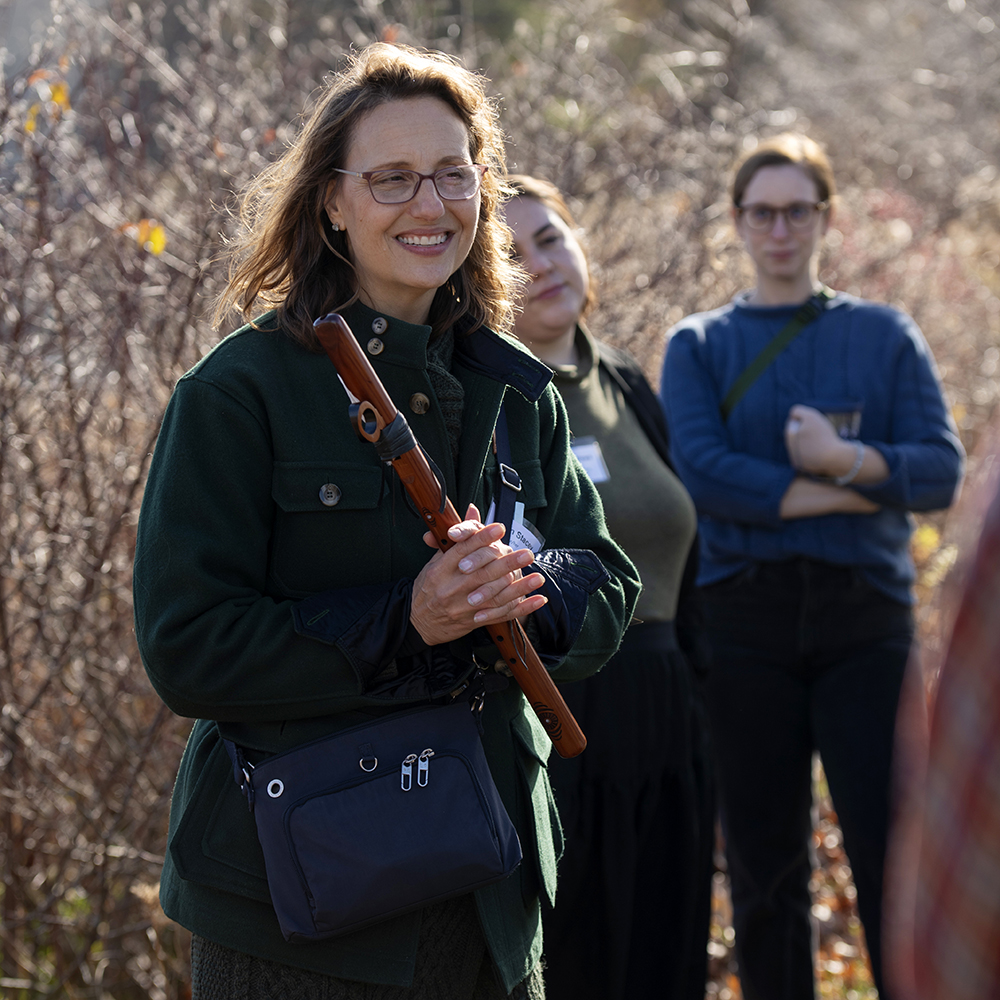On a chilly November day, a small group of people is exploring the UMass Amherst campus on a meditative walk led by Regan Stacey. She invites them into a closer relationship with their natural surroundings, pointing out birdsong, variations in the hues of the leaves, the woody scent of the trees, the warmth of the sun peeking through the clouds. For most participants, this is their first introduction to a mindfulness practice known as forest bathing. But for Stacey, a forest therapy guide and healer, it is a practice to which she has devoted her life.

Forest bathing can unlock new perspectives, even for those who may have already thought of themselves as “environmentalists.”
Forest bathing originated in Japan in the 1980s but has been gaining traction in the United States over the past decade as an antidote to our technology-obsessed society. The Japanese term for the practice, “shinrin-yoku,” translates to “forest bathing” or “absorbing the forest atmosphere” in English. Practitioners can modify the experience to fit their own needs, but the primary goal is to be mindful, relaxed, and aware in an outdoor setting. For instance, while walking through the forest may be the most common version of forest bathing, participants are not limited to forests and walking is not required. Stacey does, however, note the importance of practicing forest bathing in a group setting. While she appreciates the value of solo time spent outside, she says, “People who forest bathe on their own tend to stay still within their own headspace. But when you go with a group, it helps people extend beyond themselves more. By sharing, you’re integrating what you experienced, you’re learning from others, you’re deepening your connection to place through that exchange.”

As forest therapy has gained popularity, numerous studies have affirmed the health and wellness benefits of time spent in nature. The evidence is widespread and varied. In one study, cortisol levels, an indicator of stress, were significantly lower among forest bathing participants, and an indication that the practice can significantly reduce stress. In addition, phytoncides, essential oils found in trees, have been shown to possess antimicrobial properties that may help boost our immune systems. Research also suggests that forest therapy may reduce your blood pressure and heart rate, which lowers the risk of pulmonary disease, and help to alleviate anxiety, depression, anger, and fatigue.
Stacey experienced the healing power of nature after she was diagnosed with cancer a few years ago. During this challenging time, her spiritual journey with the forest began once she finally started “listening” and leaning into the help she knew it was trying to provide her. She was comforted by her time in nature where she was able to disengage from her thoughts, be present in the moment, and see herself as part of something much bigger. In that way, she felt as though the experience of her suffering was somehow eased by the Earth. Her desire to invite others into a similar relationship with the natural world led her to embrace forest therapy as a potential modality to serve both humans and nature. “That’s what brought me to the practice as a way to reconnect humans to nature,” she says, “to fill that void of loneliness that we have an epidemic of in our country.”
As the prevalence of chronic health issues in this country continues to grow, there are opportunities to incorporate forest bathing practices into treatments. Tami Cote, a registered nurse who works in family medicine, attended Stacey’s forest bathing session at the 2024 RCP Network Gathering, an annual conference that supports collaborative landscape conservation. After listening to Stacey’s story and learning more about the practice, she was inspired to implement forest therapy into her healthcare practice. Cote noted how integrative practices, including aromatherapy, reiki, and yoga, are increasingly promoted to support patient healing.
Stacey also sees similarities between forest bathing and yoga, another form of complementary therapy that once was relatively unknown in the West but today is a staple of many wellness routines. Similarly, Cote is hopeful that forest therapy’s integration into healthcare will continue to grow. “I believe the connection between forest bathing and healthcare is that it adds a layer to one’s sense of balance. Being truly in tune with the forest environment can bring about physical, mental, and spiritual benefits,” Cote argues. In fact, many physicians are already prescribing more time spent in nature for their patients.
Stacey argues that beyond its personal health benefits, forest bathing also has the potential to heal the human-nature divide. She describes the practice as a “deep environmental philosophical conversation” that moves beyond a simple breath of fresh air. This conversation often consists of a reciprocal exchange of help in healing, she says. As she began to trust that the forest would help her to heal, her desire to in turn help heal the forest grew. She found that the immersion of one’s senses in the natural world, a crucial component of this experience, can serve as inspiration for people to reconnect with nature, and, in doing so, nurture a drive to protect it.
Stacey’s clients have included environmental professionals from a variety of backgrounds, including science, conservation, and law. One may presume that those working in the environmental field already have a strong bond with the natural world. However, Stacey says that even environmental professionals leave a forest bathing session with a renewed sense of their relationship with nature. “There are people who are very much on the environmental side of things and being proactive, but their relationship is not encompassing with the natural world,” she says. Forest bathing can unlock new perspectives, even for those who may have already thought of themselves as “environmentalists.”
Immersion of one’s senses in the natural world, a crucial component of this experience, can serve as inspiration for people to reconnect with nature.
This mindful practice can help people cultivate an “ecological consciousness,” Stacey suggests. Through contemplation in the forest, folks can begin to realize their interdependence with the Earth and their place within the cosmos. This realization, combined with the positive impact of forest bathing on cortisol levels and its benefits for physical and mental wellbeing, offers an opportunity for people to relax and be comforted. Forest therapy guides like Stacey create safe and meaningful spaces for this to occur, but participants’ own interaction with their natural environment is the true source of their healing.
Stacey hopes forest bathing will continue to gain acceptance in this country as more people begin to realize the numerous benefits it can provide. As Cote says, “There are many ways to heal, and it is often a combination of practices that facilitate the journey.” Forest bathing presents new opportunities for healing, not just for improving one’s own physical and mental wellbeing, but also to restore the intrinsic connections between humans and all life on Earth.